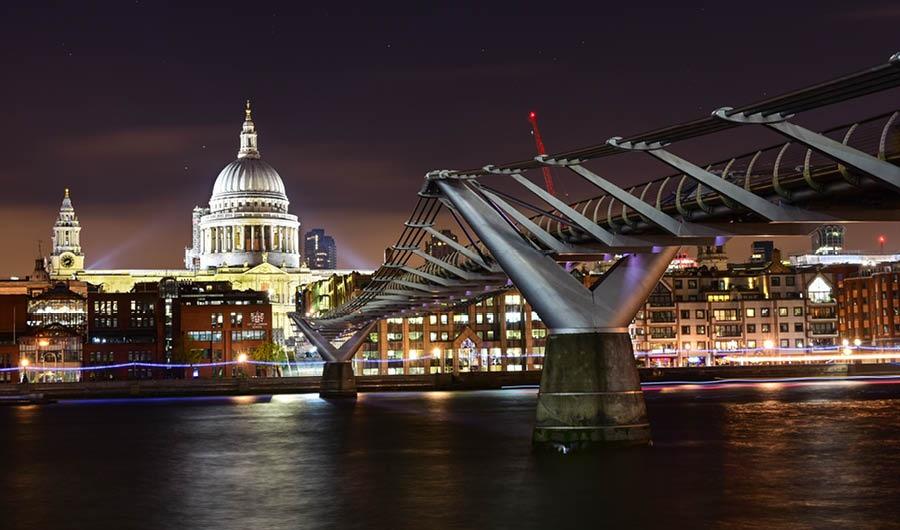A history of London in four fascinating attractions
We explore the capital’s turbulent past through some of its most iconic building.
Shakespeare’s Globe Theatre
It might seem strange to include a modern building when we’re embarking on a history of London’s past. But not only is Shakespeare’s Globe on Bankside a virtually identical replica of the original open air ‘Wooden O’ which opened in 1599 at the height of the English Renaissance, it is also constructed from many of the same materials – oak beams and plaster for the walls and a thatched roof made from water reeds which were in plentiful supply when the River Thames served as the main transport artery for the city.
Bankside in the 17th century was the equivalent of today’s West End, teaming with alehouses, bear baiting, cock fighting and other temptations. Elizabethan theatres, in fact, were deemed by many Londoners to be responsible for the rise in crime – due to the bawdy nature of the plays – and for the spread of the Bubonic Plague, which would later force owners to close the Globe for periods to help prevent the disease’s proliferation.
Shakespeare had a financial as well as an artistic stake in the Globe, and so had an interest in attracting as wide an audience as possible. Though not seen as respectable, theatres were hugely popular with all levels of society. Ordinary folk paid a penny – if they were prepared to stand as ‘groundlings’ in the yard around the stage come rain or shine – while the wealthy could afford a bench, a box or even a seat on the stage alongside the resting actors.
St Paul’s Cathedral
Christopher Wren’s architectural masterpiece – designed before the previous church was destroyed by the Great Fire of London in 1666 – epitomises the ideals of the Enlightenment, which saw a flourishing of philosophical debate and writing in the years that followed Oliver Cromwell’s overthrow of King Charles I.
Formally declared complete in 1711, St Paul’s was the first English cathedral built after the Reformation – and the first where the choir sang in English. It is noted for its elegant baroque style that married classical restraint with showy extravagance. The cathedral inspired 17th-century poet James Wright to note: ‘Without, within, below, above, the eye is filled with unrestrained delight.’ However, not everyone was quite so enamoured, with one, more sectarian, critic complaining that there ‘was an air of Popery about the gilded capitals, the heavy arches’.
The completion of the famous dome coincided with works by some of the men and women who would chronicle London life in this extraordinary era: diarist Samuel Pepys, Daniel Defoe (whose seminal Journal of a Plague Year recorded streets now lost), poets Anne Finch and John Donne (who later became Dean of St Paul’s) and engraver William Hogarth all left their mark – as did that other great landmark of the baroque age, the British Museum.
Houses of Parliament (and Big Ben)
The Palace of Westminster, once home to kings and queens, is now the seat of centralised political power in the UK. One of the most iconic landmarks in the city, it was mostly the work of Charles Barry, who commissioned a young architect named Augustus Pugin
to provide the ornate interiors.
Pugin, who also worked on the Queen Elizabeth Tower and the bell inside (affectionately known as ‘Big Ben’), influenced Sir Gilbert Scott, who would design the Gothic station at St Pancras. Other popular buildings of the time include the Victoria and Albert Museum by Aston Webb, who also designed Buckingham Palace and the Queen Victoria Monument opposite, at the start of the Mall.
Victoria’s reign gave rise to some of the most enduring landmarks in the capital and overseas – this was the age of empire after all. In 1851, the Great Exhibition drew thousands of visitors daily to Hyde Park, where goods from Britain and its colonial domains were displayed to the world.
Tate Modern
Industry and art come together in this postmodern cathedral dedicated to modern art, housed in a cavernous former power station designed by Giles Gilbert Scott. The gallery, famous for large-scale temporary exhibitions as well as retrospectives of contemporary artists, occupies a commanding position on the river, with the Millennium Bridge connecting it to St Paul’s Cathedral on the other side of the Thames.
Sister museum to Tate Britain, further down the river in Pimlico, Tate Modern has proved to be one of the most visited attractions in the capital since it opened in 1997. More than five million people pass through every year, many of whom will have also enjoyed the London Eye, another icon of the pre-millennial boom that shook London. This giant wheel opposite Westminster has now become a permanent fixture on the South Bank.
An extension to the gallery, by architects Herzog & de Meuron who worked on the original conversion, doubled the space available when it opened in 2016.
